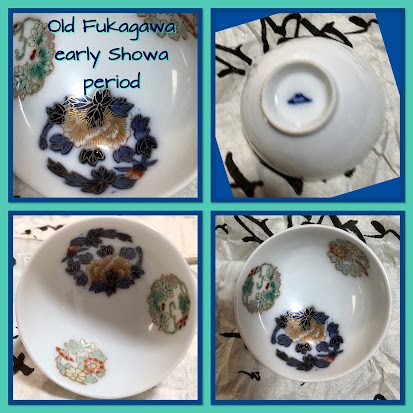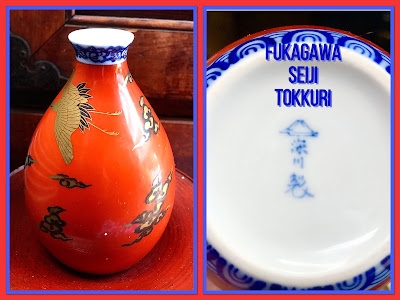I am building a collection of marks with their general time periods. It is a work in progress.
I am thankful for the book "Meiji Arita..." for help with additional marks of the Meiji period.
Both Fukagawa Seiji and Koransha were established by the Fukagawa Family (with others) and they have held the leadership in both companies throughout. Seiji Kaisha is interwoven in the mix as well, having been established by Koransha people (which lasted about twenty years).
The Fukagawa family made ceramics for generations but in 1879 they established Koransha. After the death of the father in 1889, the second son began Fukagawa Seiji in 1894. Obviously the companies are intertwined as they are both headed by Fukagawa descendants.
Here are some helpful sites for both Koransha and Fukagawa Seiji (some English, some in Japanese with great pictures):
http://www.koransha.co.jp/koransha/koransha_english.html
http://www.fukagawa-seiji.co.jp/cotp/forenglish.html
http://www.fukagawa-seiji.co.jp/archive/index.php
http://www.ac.cyberhome.ne.jp/~momochi-linden/aaa.html
This one is in Japanese but has some Fukagawa and Koransha marks ranging from late Meiji to early Showa period.
MARKS
I will break the marks down by decade as a general rule, but keep in mind that there will be overlap as Fukagawa/ Koransha did not start and stop marks by decade. Some marks continued for decades.
Circa1860's
Hichozan Fukagawa Sei c. 1868-1870
Circa 1870's
Circa 1880's
Circa 1890's
Lesser quality ware sold after the close of the company
Seiji Kaisha 1879-1897 ( the Seiji Kaisha mark was used for several years after the close of the company). The lesser quality wares were decorated after the close of the company by former workers and others who used the Seiji a Kaisha mark. Trademark laws were not created at that time. Marked blanks were later decorated and sold by others.
Circa 1900's-1920

C. 1900-1910
Circa 1920's
According to the Koransha company website this mark was from the early Showa Period 1926~
Circa 1930's
This Koransha vase is believed to be circa 1930's
Pre war
Pre war
Circa 1940's
During the war years production continued domestically to some extent under government control, but there were no exports.
Circa 1950's/1960's
Used on dinner ware for foreign markets
Circa 1970's~

KORANSHA
From 1975~
Circa 1980~
Fukagawa
Fukagawa Iroe Saiji Mark from latter part of 20th Century (c.1980's)
.
******************************************
2015 Store Fukuoka Daimaru Display
Also see: http://www.meiji-imari.com/en/meijiimari_en/meijiimari03.html
http://www.fukagawa-seiji.co.jp/archive/index.php*****************
*************






































I have 2 Small Fukagawa Mini vases with a picture of Mt. Fuji and two trees with red and orange leaves on the branches, BUT the Makers Mark on the bottom is just stamped with the Mountain and 2 rivers but in Red..?? I cannot figure out if it is Pre-War or what time frame they are from....I hope you can help me out. :)
ReplyDeleteThank You Megan Ford email me at meganrena@gmail.com
Does the mark look hand painted or printed?
DeleteThank you for this post! I found a set of 6 cups and saucers and a matching ashtray that is marked with what seems to be the Koransha mark from the 1920's, or possibly the 1930's. The pattern is sort of art deco in a cobalt and white geometric pattern. I've searched and searched and can't find a picture of anything that matches that would give me a pattern name or number or tell me what else was made in that pattern. I've searched several different search engines, china sites, eBay, Etsy, etc., with variations of Koransha blue cobalt cups ashtray geometric art deco - anything I could think of, but no luck. Do you have any suggestions for what I could do next?
ReplyDeleteWithout seeing of course I can’t help too much. That being said, to my knowledge Koransha does not have pattern numbers, and few pattern names, especially on early pieces. In a quick search in Japanese I did not find anything using your description.
ReplyDeleteThank you for answering. I'll see if I can figure out a way to post picture somewhere and post the link here.
ReplyDeleteThank you for making this blog post! It helped me date the Fukagawa tea set I found at a thrift store!
ReplyDeleteHi, I have a vase with a gold Fukagawa mark and I still don't understand it.I wish I could post it!
ReplyDeleteThanks.
I have several sets of Koransha ware. Are they still making Koransha?
ReplyDeleteKoransha is still going strong!
ReplyDeleteI wanted to thank you for this excellent read!! I definitely loved every little bit of it. I have you bookmarked your site to check out the new stuff you post. Koransha
ReplyDeleteI am glad you find it interesting.
DeleteHave you seen the new entry for 1945-1950 Fukagawa on Gotheborg site? I do not believe this to be correct. What do you think?
ReplyDeleteThanks,
Pat
Hi Pat. That actually is not recent (they don’t update over there much at all). Years ago I sent corrections on some of their Japanese marks. It took years for some to be corrected. People treat that site as a “marks bible” but there are many errors, at least as far as Japanese marks go. I don’t know how many times people corrected me by using Gbg as a reference, when I actually had Japanese references ( books, company websites, etc.) or had actually visited the makers/companies and spoke with them. As far as that mark, I am away from my reference library right now, but as far as I know that mark was never used by Fukagawa, Koransha or Seiji Kaisha affiliated companies. It looks like an old Arita/ Imari mark.
Delete